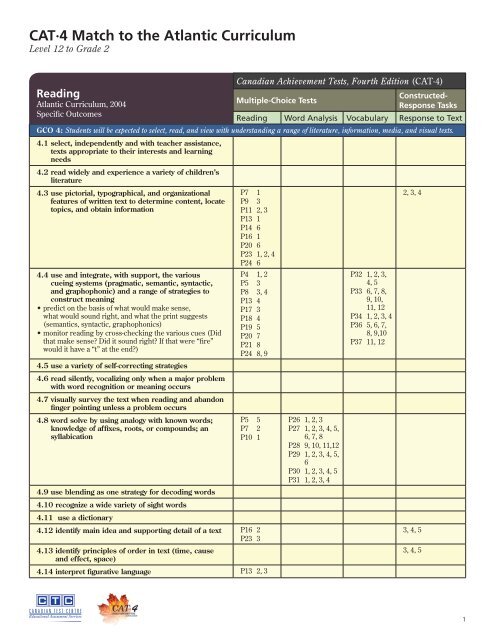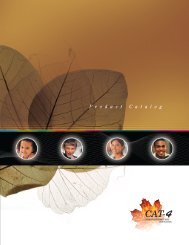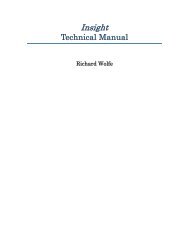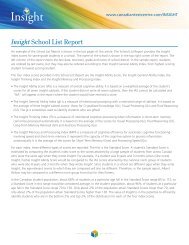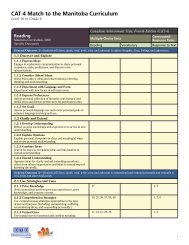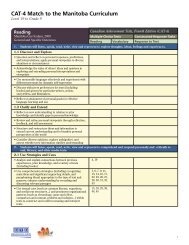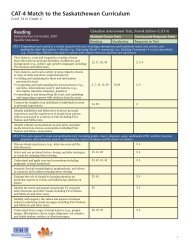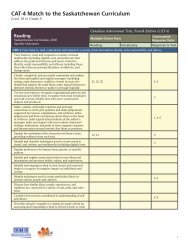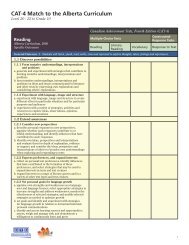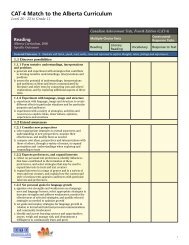Grade 2 - Canadian Test Centre
Grade 2 - Canadian Test Centre
Grade 2 - Canadian Test Centre
Create successful ePaper yourself
Turn your PDF publications into a flip-book with our unique Google optimized e-Paper software.
CAT∙4 Match to the Atlantic Curriculum<br />
Level 12 to <strong>Grade</strong> 2<br />
Reading<br />
Atlantic Curriculum, 2004<br />
Specific Outcomes<br />
<strong>Canadian</strong> Achievement <strong>Test</strong>s, Fourth Edition (CAT·4)<br />
Multiple-Choice <strong>Test</strong>s<br />
Constructed-<br />
Response Tasks<br />
Reading Word Analysis Vocabulary Response to Text<br />
GCO 4: Students will be expected to select, read, and view with understanding a range of literature, information, media, and visual texts.<br />
4.1 select, independently and with teacher assistance,<br />
texts appropriate to their interests and learning<br />
needs<br />
4.2 read widely and experience a variety of children’s<br />
literature<br />
4.3 use pictorial, typographical, and organizational<br />
features of written text to determine content, locate<br />
topics, and obtain information<br />
4.4 use and integrate, with support, the various<br />
cueing systems (pragmatic, semantic, syntactic,<br />
and graphophonic) and a range of strategies to<br />
construct meaning<br />
• predict on the basis of what would make sense,<br />
what would sound right, and what the print suggests<br />
(semantics, syntactic, graphophonics)<br />
• monitor reading by cross-checking the various cues (Did<br />
that make sense Did it sound right If that were “fire”<br />
would it have a “t” at the end)<br />
4.5 use a variety of self-correcting strategies<br />
4.6 read silently, vocalizing only when a major problem<br />
with word recognition or meaning occurs<br />
4.7 visually survey the text when reading and abandon<br />
finger pointing unless a problem occurs<br />
4.8 word solve by using analogy with known words;<br />
knowledge of affixes, roots, or compounds; an<br />
syllabication<br />
4.9 use blending as one strategy for decoding words<br />
4.10 recognize a wide variety of sight words<br />
4.11 use a dictionary<br />
P7 1<br />
P9 3<br />
P11 2, 3<br />
P13 1<br />
P14 6<br />
P16 1<br />
P20 6<br />
P23 1, 2, 4<br />
P24 6<br />
P4 1, 2<br />
P5 3<br />
P8 3, 4<br />
P13 4<br />
P17 3<br />
P18 4<br />
P19 5<br />
P20 7<br />
P21 8<br />
P24 8, 9<br />
P5 5<br />
P7 2<br />
P10 1<br />
4.12 identify main idea and supporting detail of a text P16 2<br />
P23 3<br />
4.13 identify principles of order in text (time, cause<br />
and effect, space)<br />
4.14 interpret figurative language P13 2, 3<br />
P26 1, 2, 3<br />
P27 1, 2, 3, 4, 5,<br />
6, 7, 8<br />
P28 9, 10, 11,12<br />
P29 1, 2, 3, 4, 5,<br />
6<br />
P30 1, 2, 3, 4, 5<br />
P31 1, 2, 3, 4<br />
P32 1, 2, 3,<br />
4, 5<br />
P33 6, 7, 8,<br />
9, 10,<br />
11, 12<br />
P34 1, 2, 3, 4<br />
P36 5, 6, 7,<br />
8, 9,10<br />
P37 11, 12<br />
2, 3, 4<br />
3, 4, 5<br />
3, 4, 5<br />
1
CAT∙4 Match to the Atlantic Curriculum<br />
Level 12 to <strong>Grade</strong> 2<br />
Reading<br />
Atlantic Curriculum, 2004<br />
Specific Outcomes<br />
4.15 use clues from the text and personal experiences<br />
to gain and understanding of character<br />
4.16 recognize different emotions and empathize with<br />
literary characters<br />
<strong>Canadian</strong> Achievement <strong>Test</strong>s, Fourth Edition (CAT·4)<br />
Multiple-Choice <strong>Test</strong>s<br />
Constructed-<br />
Response Tasks<br />
Reading Word Analysis Vocabulary Response to Text<br />
P14 5, 7<br />
P23 5<br />
P9 7<br />
P14 5, 7<br />
4.17 recognize the elements of a story or plot P9 6 4, 5<br />
4.18 use prereading/previewing strategies, such as<br />
• predicting what the text will be about based on its title and<br />
pictures, as well as their personal experiences with the<br />
topic<br />
• making connections between what they read and their<br />
own experiences and knowledge<br />
• setting their own purposes for reading/viewing<br />
• asking themselves questions about what they want to find<br />
out<br />
4.19 use during reading/viewing strategies, such as<br />
• verifying and adjusting predictions/making further<br />
predictions<br />
• making connections between what they read and their<br />
own experiences and knowledge<br />
• visualizing characters, settings, and situations (making<br />
pictures in their minds)<br />
4.20 use after-reading/viewing strategies such as<br />
• reflecting about the text<br />
• responding to the text (through talking, writing, or some<br />
other means of representation)<br />
• ask questions about the text<br />
4.21 describe their own reading and viewing processes<br />
and strategies<br />
P23 4<br />
P5 4<br />
P24 7<br />
GCO 6: Students will be expected to respond personally to a range of texts.<br />
6.1 make personal connections to text and describe,<br />
share, and discuss their reactions and emotions<br />
6.2 express and explain opinions about texts and types<br />
of texts, and the work of authors and illustrators<br />
demonstrating and increasing awareness of the<br />
reasons for their opinions<br />
1, 6<br />
P11 4 1, 2, 3, 5<br />
GCO 7: Students will be expected to respond critically to a range of texts, applying their knowledge of language, form and genre.<br />
7.1 question information presented in print and visual<br />
texts<br />
• use a personal knowledge base as a frame of reference<br />
7.2 identify some different types of print and media<br />
texts<br />
• recognizing some of their language conventions and text<br />
characteristics<br />
• recognize that these conventions and characteristics help<br />
them understand what they read and view<br />
6<br />
1, 2<br />
2
CAT∙4 Match to the Atlantic Curriculum<br />
Level 12 to <strong>Grade</strong> 2<br />
Reading<br />
Atlantic Curriculum, 2004<br />
Specific Outcomes<br />
7.3 respond critically to texts<br />
• formulate questions as well as understandings<br />
• identify the point of view in a text and demonstrate an<br />
awareness of whose voices/positions are and are not<br />
being expressed<br />
• discuss the text from the perspective of their own realities<br />
and experiences<br />
• identify instances of prejudice, bias, and stereotyping<br />
<strong>Canadian</strong> Achievement <strong>Test</strong>s, Fourth Edition (CAT·4)<br />
Multiple-Choice <strong>Test</strong>s<br />
Constructed-<br />
Response Tasks<br />
Reading Word Analysis Vocabulary Response to Text<br />
1<br />
3
CAT∙4 Match to the Atlantic Curriculum<br />
Level 12 to <strong>Grade</strong> 2<br />
Writing<br />
Atlantic Curriculum, 2004<br />
Specific Outcomes<br />
<strong>Canadian</strong> Achievement <strong>Test</strong>s, Fourth Edition (CAT·4)<br />
Multiple-Choice <strong>Test</strong>s<br />
Writing<br />
Conventions<br />
Spelling<br />
Constructed-Response Tasks<br />
Writing<br />
GCO 8: Students will be expected to use writing and other forms of representation to explore, clarify, and reflect on their thoughts, feelings,<br />
experiences, and learnings; and to use their imaginations<br />
8.1 use writing and other forms of representation to<br />
• formulate questions<br />
• generate and organize language and ideas<br />
• discover and express personal attitudes and opinions<br />
• express feelings and imaginative ideas<br />
• record experiences<br />
• explore how and what they learn<br />
8.2 explore, with assistance, ways for making their<br />
own note<br />
8.3 experiment with language choices in imaginative<br />
writing and other ways of representing<br />
1, 2, 3, 4<br />
P43 1, 2, 3<br />
P44 4<br />
1, 2, 5<br />
P45 1, 2<br />
P46 5<br />
GCO 9: Students will be expected to create texts collaboratively and independently, using a variety of forms for a range of audiences and<br />
purposes.<br />
9.1 create written and media texts using a variety of<br />
forms<br />
• experiment with a combination of writing with other<br />
media to increase the impact of their presentations<br />
9.2 demonstrate some awareness of purpose and<br />
audience<br />
• make choices about form for specific purpose/audience<br />
• realize that work to be shared with an audience needs<br />
editing<br />
9.3 consider their readers’/viewers’/listeners’<br />
questions, comments and other responses in<br />
assessing their work and extending their learning<br />
1, 2, 4, 5<br />
P45 1, 2, 3<br />
P46 5<br />
GCO 10: Students will be expected to use a range of strategies to develop effective writing and media products to enhance their clarity,<br />
precision, and effectiveness<br />
10.1 experiment with a range of prewriting, drafting,<br />
revising, editing, proofreading, and presentation<br />
strategies<br />
• use a variety of prewriting strategies for generating and<br />
organizing ideas for writing<br />
• use appropriate drafting techniques (focusing on getting<br />
ideas on paper, taking risks with temporary spelling when<br />
necessary, experimenting with new forms/techniques,<br />
keeping audience in mind, using a word processor to<br />
compose)<br />
• use revision techniques to ensure writing makes sense<br />
and is clear for the audience<br />
• use editing strategies<br />
• use appropriate techniques for publishing/presenting<br />
P45 1, 2, 3, 4<br />
P46 5, 6, 7, 8,<br />
9<br />
1, 2, 3, 4, 5<br />
P45 1, 2, 3, 4<br />
P46 5<br />
4
CAT∙4 Match to the Atlantic Curriculum<br />
Level 12 to <strong>Grade</strong> 2<br />
Writing<br />
Atlantic Curriculum, 2004<br />
Specific Outcomes<br />
<strong>Canadian</strong> Achievement <strong>Test</strong>s, Fourth Edition (CAT·4)<br />
Multiple-Choice <strong>Test</strong>s<br />
Writing<br />
Conventions<br />
Spelling<br />
Constructed-Response Tasks<br />
Writing<br />
General Outcome 4—Students will listen, speak, read, write, view and represent to enhance the clarity and artistry of communication.<br />
10.2 use some conventions of written language<br />
• punctuation and capitalization<br />
» use capitals for proper names, titles, places, days,<br />
months, holidays, beginning of sentences<br />
» use periods at the ends of sentences and for<br />
abbreviation<br />
» use commas in a series and in dates<br />
» use apostrophes for possessives and contractions<br />
» use question marks, exclamation marks, and<br />
quotation marks<br />
• language structure<br />
» make subject and verbs agree<br />
» begin to use simple paragraphing<br />
» use a variety of simple and more complex sentence<br />
structures<br />
» use pronouns appropriately<br />
• spelling<br />
» use meaning and syntax patterns as well as sound<br />
cues<br />
» use a range of spelling strategies<br />
» spell many words conventionally<br />
» use a variety of strategies to edit for spelling<br />
(identifying misspelled words, trying them another<br />
way, and using another resource to check them out)<br />
10.3 demonstrate engagement with the creation of<br />
pieces of writing and other representations<br />
• engage in writing/representing activities for sustained<br />
periods of time<br />
• work willingly on revising and editing for an audience<br />
• demonstrate pride and sense of ownership in writing/<br />
presenting efforts<br />
10.4 experiment with technology in writing and other<br />
forms of representing<br />
• use a tape recorder to tape dramatic presentations,<br />
readings of published work, and retellings<br />
• use a simple word processing program to draft, revise,<br />
edit, and publish<br />
• use a drawing program (computer software)<br />
• with assistance, use a database, CD-ROM, and the<br />
Internet as resource for finding information (prewriting<br />
strategy)<br />
• with assistance use the Internet to communicate<br />
10.5 select, organize, and combine relevant<br />
information, with assistance, from at least two<br />
sources, without copying verbatim, to construct<br />
and communicate meaning<br />
P40 1, 2, 3, 4,<br />
5, 6<br />
P41 7, 8, 9, 10,<br />
11<br />
P42 12, 13, 14,<br />
15<br />
P43 1, 2, 3<br />
P44 1, 2, 3<br />
1, 2, 3, 4, 5, 6,<br />
7, 8, 9, 10, 11,<br />
12, 13, 14, 15,<br />
16, 17, 18, 19,<br />
20<br />
1, 2, 3, 4, 5<br />
5
CAT∙4 Match to Atlantic Curriculum<br />
Level 12 to <strong>Grade</strong> 2<br />
Mathematics<br />
Atlantic Provinces Curriculum, 1998<br />
Strand: Number<br />
General Outcome: Develop number sense.<br />
1. Say the number sequence 0 to 100 by:<br />
• 2s, 5s and 10s, forward and backward, using starting<br />
points that are multiples of 2, 5 and 10 respectively<br />
• 10s, using starting points from 1 to 9<br />
• 2s, starting from 1.<br />
[C, CN, ME, R]<br />
2. Demonstrate if a number (up to 100) is even or odd.<br />
[C, CN, PS, R]<br />
3. Describe order or relative position, using ordinal<br />
numbers (up to tenth).<br />
[C, CN, R]<br />
4. Represent and describe numbers to 100, concretely,<br />
pictorially and symbolically.<br />
[C, CN, V]<br />
5. Compare and order numbers up to 100.<br />
[C, CN, ME, R, V]<br />
6. Estimate quantities to 100, using referents.<br />
[C, ME, PS, R]<br />
7. Illustrate, concretely and pictorially, the meaning of<br />
place value for numerals to 100.<br />
[C, CN, R, V]<br />
8. Demonstrate and explain the effect of adding zero<br />
to, or subtracting zero from, any number<br />
[C, R]<br />
9. Demonstrate an understanding of addition (limited<br />
to 1- and 2-digit numerals) with answers to 100 and<br />
the corresponding subtraction by:<br />
• using personal strategies for adding and subtracting with<br />
and without the support of manipulatives<br />
• creating and solving problems that involve addition and<br />
subtraction<br />
• using the commutative property of addition (the order in<br />
which numbers are added does not affect the sum)<br />
• using the associative property of addition (grouping a set<br />
of numbers in different ways does not affect the sum)<br />
• explaining that the order in which numbers are subtracted<br />
may affect the difference.<br />
[C, CN, ME, PS, R, V]<br />
<strong>Canadian</strong> Achievement <strong>Test</strong>s, Fourth Edition (CAT·4)<br />
Multiple-Choice <strong>Test</strong>s<br />
Constructed-Response Tasks<br />
Mathematics Computation Math Processes<br />
31<br />
P61 7<br />
5, 8, 25<br />
P49 5<br />
P51 8<br />
P58 1<br />
3, 4, 11<br />
P49 3, 4<br />
P53 11<br />
33<br />
P62 9<br />
12, 13, 17, 26,<br />
38<br />
P53 12, 13<br />
P55 17<br />
P58 2<br />
P63 14<br />
19, 20, 43 P68 1, 2, 3, 4, 5,<br />
6, 7<br />
P69 8, 9, 10, 11,<br />
12<br />
P70 1, 2, 3, 4, 5,<br />
6, 7<br />
P71 8, 9, 10, 11,<br />
12<br />
P72 1, 2, 3, 4, 5<br />
P73 9, 10<br />
P74 12<br />
6
CAT∙4 Match to Atlantic Curriculum<br />
Level 12 to <strong>Grade</strong> 2<br />
Mathematics<br />
Atlantic Provinces Curriculum, 1998<br />
10. Apply mental mathematics strategies, such as:<br />
• using doubles<br />
• making 10<br />
• one more, one less<br />
• two more, two less<br />
• building on a known double<br />
• thinking addition for subtraction for basic addition facts<br />
and related subtraction facts to 18.<br />
[C, CN, ME, PS, R, V]<br />
Strand: Patterns and Relations (Patterns)<br />
General Outcome: Use patterns to describe the world and to solve problems<br />
1. Demonstrate an understanding of repeating patterns<br />
(three to five elements) by:<br />
• describing<br />
• extending<br />
• comparing<br />
• creating<br />
patterns using manipulatives, diagrams,sounds and actions.<br />
[C, CN, PS, R, V]<br />
2. Demonstrate an understanding of increasing patterns<br />
by:<br />
• describing<br />
• reproducing<br />
• extending<br />
• creating<br />
numerical (numbers to 100) and non-numerical patterns<br />
using manipulatives, diagrams, sounds and actions.<br />
[C, CN, PS, R, V]<br />
3. Sort a set of objects, using two attributes, and<br />
explain the sorting rule.<br />
[C, CN, R, V]<br />
4. Demonstrate and explain the meaning of equality<br />
and inequality, concretely and pictorially.<br />
[C, CN, R, V]<br />
5. Record equalities and inequalities symbolically, using<br />
the equal symbol or the not equal symbol.<br />
[C, CN, R, V]<br />
<strong>Canadian</strong> Achievement <strong>Test</strong>s, Fourth Edition (CAT·4)<br />
Multiple-Choice <strong>Test</strong>s<br />
Constructed-Response Tasks<br />
Mathematics Computation Math Processes<br />
2, 14, 27, 40,<br />
47, 48<br />
P48 2<br />
P54 14<br />
P59 3<br />
P64 16<br />
P66 23<br />
P67 24<br />
22, 34, 35, 44,<br />
45<br />
P57 22<br />
P62 10<br />
P63 11<br />
P65 20<br />
P66 21<br />
Strand: Shape and Space (Measurement)<br />
General Outcome: Use direct and indirect measurement to solve problems.<br />
1. Relate the number of days to a week and the<br />
number of months to a year in a problem-solving<br />
context.<br />
[C, CN, PS, R]<br />
2. Relate the size of a unit of measure to the number<br />
of units (limited to nonstandard units) used to<br />
measure length and mass (weight).<br />
[C, CN, ME, R, V]<br />
21, 24<br />
P56 21<br />
P57 24<br />
16, 23<br />
P54 16<br />
P57 23<br />
P72 6, 7 ,8<br />
P74 11<br />
7
CAT∙4 Match to Atlantic Curriculum<br />
Level 12 to <strong>Grade</strong> 2<br />
Mathematics<br />
Atlantic Provinces Curriculum, 1998<br />
3. Compare and order objects by length, height,<br />
distance around and mass (weight), using<br />
nonstandard units, and make statements of<br />
comparison.<br />
[C, CN, ME, R, V]<br />
4. Measure length to the nearest nonstandard unit by:<br />
• using multiple copies of a unit<br />
• using a single copy of a unit (iteration process).<br />
[C, ME, R, V]<br />
5. Demonstrate that changing the orientation of an object<br />
does not alter the measurements of its attributes.<br />
[C, R, V]<br />
<strong>Canadian</strong> Achievement <strong>Test</strong>s, Fourth Edition (CAT·4)<br />
Multiple-Choice <strong>Test</strong>s<br />
Constructed-Response Tasks<br />
Mathematics Computation Math Processes<br />
39<br />
P64 15<br />
46<br />
P66 22<br />
Strand: Shape and Space (3-D Objects and 2-D Shapes)<br />
General Outcome: Describe the characteristics of 3-D objects and 2-D shapes, and analyze the relationships among them.<br />
6. Sort 2-D shapes and 3-D objects, using two<br />
attributes, and explain the sorting rule.<br />
[C, CN, R, V]<br />
7. Describe, compare and construct 3-D objects,<br />
including:<br />
• cubes<br />
• spheres<br />
• cones<br />
• cylinders<br />
• pyramids.<br />
[C, CN, R, V]<br />
8. Describe, compare and construct 2-D shapes,<br />
including:<br />
• triangles<br />
• squares<br />
• rectangles<br />
• circles.<br />
[C, CN, R, V]<br />
9. Identify 2-D shapes as parts of 3-D objects in the<br />
environment.<br />
[C, CN, R, V]<br />
6<br />
P49 6<br />
15, 28, 30<br />
P54 15<br />
P59 4<br />
P60 6<br />
Strand: Statistics and Probability (Data Analysis)<br />
General Outcome: Collect, display and analyze data to solve problems.<br />
1. Gather and record data about self and others to<br />
answer questions.<br />
[C, CN, PS, V]<br />
2. Construct and interpret concrete graphs and<br />
pictographs to solve problems.<br />
[C, CN, PS, R, V]<br />
20, 42<br />
P56 20<br />
P65 18<br />
1, 7, 9, 10, 18,<br />
32, 41<br />
P48 1<br />
P50 7<br />
P52 9, 10<br />
P55 18<br />
P62 8<br />
P64 17<br />
8


